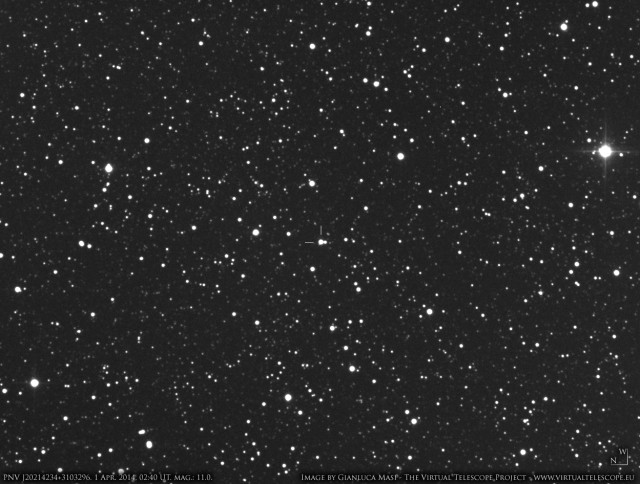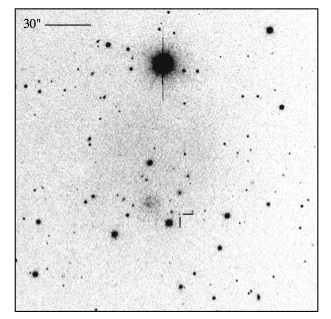ALERT OSSERVATIVI CATACLISMICHE E NOVAE
Da Sezione Stelle Variabili - Unione Astrofili Italiani.
Nova Cygni 2014 PNV J20214234+3103296
Alert osservativa AAVSO N.500 da notizia di una brillante nova nel Cigno al momento della scoperta di magnitudine 10.9 non filtrata quindi alla portata di piccoli strumenti e chi volesse anche visuale.Ogni tipo di osservazione è consigliata anche filtrate vista la natura abbastanza rossastra della stella. Per il momento in mancanza di designazione le osservazioni vanno inviate ad AAVSO con il nome NOVA Cyg 20014
Da spettri raccolti la stella risulta essere una classica nova di tipi Fe-II vicina al massimo.
foto di campo di Gianluca Masi
di seguito l'allerta e coordinate
Event: Nova Cygni 2014 = PNV J20214234+3103296
Discovered by: Koichi Nishiyama (Kurume, Japan) and Fujio Kabashima (Miyaki, Japan)
Discovery magnitude: magnitude 10.9 unfiltered CCD, using a 105-mm-f.l. f/4 camera lens (+ SBIG STL6303E camera)
Discovery date: 2014 Mar. 31.790 UT
Coordinates: R.A. 20 21 42.32, Decl. +31 03 29.4 (equinox 2000.0) from G. Masi, F. Nocentini, and P. Schmeer, remotely as described below, via CBET 3842
Spectra: Spectra obtained on 2014 Apr. 1 by U. Munari et al. (Istituto Nazionale di Astrofisica, Padova Astron. Obs., Italy), by A. Arai et al. (Nishi-Harima Astron. Obs., University of Hyogo, Japan), by K. Ayani (Bisei Astron. Obs., Ibara, Okayama, Japan), and by M. Fujii (Fujii Kurosaki Obs., Kurashiki, Okayama, Japan) all indicate a highly reddened classical Fe II-type nova around maximum. See CBET 3842 for spectra details; spectra URLs in Note f.
Observing recommendations: Observations of all types (visual, CCD, DSLR, spectroscopy) are strongly encouraged in following the evolution of this nova. Filtered observations are preferred if possible due to the reddened nature of this object.
Charts: Nova Cyg 2014 has been added to the International Variable Star Index (VSX, http://www.aavso.org/vsx). Finder charts with a comparison star sequence may be created using the AAVSO Variable Star Plotter (VSP, http://www.aavso.org/vsp).
Submit observations: Please submit observations to the AAVSO International Database using the name NOVA CYG 2014. Once a GCVS name has been assigned, please use that name.
Nova Sagittarii 2014 = PNV J18250860-2236024
Spettri a bassa risoluzione della stella hanno rivelato trattarsi di una classica nova FE II-tipo past massimo. Scesa nei giorni scorsi alla 11.5V è risalita alla 9.8V. Osservazioni di qualsiasi tipo anche visuali sono richieste da AAVSO nella loro alert 497 che allego. Le osservazioni inviate al database aavso devono avere come nome della stella NOVA SGR 2014
February 11, 2014
1. Event: Nova Sagittarii 2014 = PNV J18250860-2236024
Discovered by: Sigeru Furuyama (Tone-machi, Ibaraki-ken, Japan) and reported by S. Nakano (Sumoto, Japan)
Discovery magnitude: unfiltered CCD magnitude 8.7, using a 200-mm f/2.8 camera lens + BJ-42L camera
Discovery date: 2014 Jan. 26.857 UT
Coordinates: R.A. 18 25 08.60 Decl. = -22 36 02.4 (2000.0)
Spectra: Low-resolution spectra obtained by A. Arai (Nishi-Harima Astronomical Observatory, University of Hyogo, Japan) on 2014 Jan. 30.87 UT indicate that the object is a Fe II-type classical nova past maximum. Spectroscopy details may be found in CBET 3802 (see Note a below).
Observing recommendations: Nova Sgr 2014, which had faded to 11.5 V, has brightened to visual magnitude 9.8. Observations of all types (visual, CCD, DSLR, spectroscopy) are strongly encouraged in following the evolution of this nova.
Charts: Charts for Nova Sgr 2014 may be created using the AAVSO Variable Star Plotter (VSP) at http://www.aavso.org/vsp.
Observations reported to the AAVSO: 2014 Jan. 27.847 UT, 9.6 (T. Noguchi, Katori, Chiba-ken, Japan, confirming observation, CBET 3802); 28.32640, 10.1 (AAX, A. Amorim, Florianopolis, Brazil); 28.48056, 10.2 (SLH, L. Shotter, Uniontown, PA); 28.83889, 10.5 (PEX, A. Pearce, Nedlands, W. Australia); 28.876, 10.19 V (KSI, S. Kiyota, Kamagaya, Japan, CBET 3802); 28.876, 9.72 Rc (Kiyota, CBET 3802); 28.876, 9.15 Ic (Kiyota, CBET 3802); 29.31460, 10.5 (Amorim); 29.39323, 10.585 +/-0.012 V (HMB, J. Hambsch, Mol, Belgium, remotely at San Pedro de Atacama, Chile); 29.39363, 9.223 +/-0.023 I (Hambsch); 30.39456, 10.826 +/-0.014 V (Hambsch); 30.39496, 9.385 +/-0.024 I (Hambsch); 31.30830, 11.0 (Amorim); 31.39523, 10.964 +/-0.014 V (Hambsch); 31.39563, 9.433 +/-0.025 I (Hambsch); Feb. 01.31250, 11.0 (Amorim); 01.39527, 10.981 +/-0.014 V (Hambsch); 01.39565, 9.563 +/-0.026 I (Hambsch); 02.31180, 11.2 (Amorim); 02.39615, 11.379 +/-0.020 V (Hambsch); 02.39656, 9.787 +/-0.042 I (Hambsch); 02.862, 10.7 (K. Kadota, Ageo, Saitama-ken, Japan, CBET 3802); 03.31250, 11.5 (Amorim); 03.39598, 11.513 +/-0.020 V (Hambsch); 03.39639, 10.028 +/-0.048 I (Hambsch); 04.39677, 11.432 +/-0.017 V (Hambsch); 04.39717, 10.239 +/-0.033 I (Hambsch); 06.39971, 10.990 +/-0.016 V (Hambsch); 06.40025, 10.177 +/-0.039 I (Hambsch); 07.39994, 11.172 +/-0.012 V (Hambsch); 07.40035, 10.333 +/-0.028 I (Hambsch); 08.30000, 11.1 (Amorim); 08.83403, 10.9 (Pearce); 09.39966, 10.604 +/-0.012 V (Hambsch); 09.40008, 9.786 +/-0.030 I (Hambsch); 09.82850, 10.8 (Pearce); 10.40196, 10.063 +/-0.010 V (Hambsch); 10.40237, 9.259 +/-0.026 I (Hambsch); 10.85140, 9.8 (Pearce);
Submit observations: Please submit observations to the AAVSO International Database using the name NOVA SGR 2014. Once a GCVS name has been assigned, please use that name.
GR Ori in super-outburst
Rod Stubbings dall'Australia riporta un outburst della sospetta vecchia nova (Nova Ori 1916),stimandola visualmente di magnitudine 13.0 a Febbraio 11.476 UT (JD 2456334.976).Questa osservazione è stata confermata da Stephen Howell (New Zealand),che ha ugualmente riportato la stella a magnitudine 13.0 Febbraio 11.461.Mike Simonsen (AAVSO) fa notare che la sospetta progenitrice di questa stella ha una magnitudine intorno alla 22.8 nella Sloan Digital Sky Survey,suggerendo un ampio outburst di 8-10 magnitudini,e che la stella potrebbe essere una WZ Sge dwarf nova piuttosto che una nova classica o ricorrente.La maggioranza delle osservazioni di questa stella sono visuali e il comportamento degli outburst è poco studiato.Naturalmente si sono notati aumenti di luminosità nei decenni passati.
Osservazioni di GR Ori,specialmente time series in V sono richieste ed aiuterebbero a comprendere meglio questo oggetto.
GR Ori si trova:
R.A. 05 21 34.98 Dec +01 10 10.2 (2000.0)
La sequenza e le stelle di confronto sono state aggiornate e si trovano sul sito AAVSO http://www.aavso.org/vsp
Per chi disponesse di un codice AAVSO le osservazioni vanno inviate come GR Ori
qui la alert AAVSO http://www.aavso.org/aavso-special-notice-334
22:05, 12 feb 2013 (UTC)


